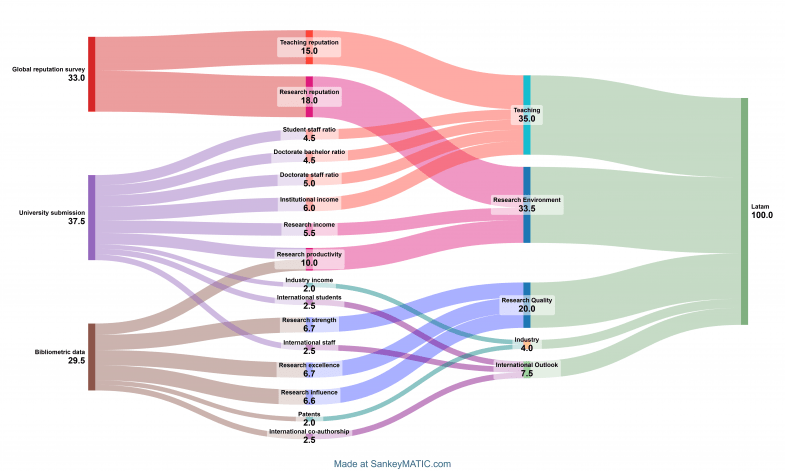Updated 29 October 2024
Latin America is one of the most dynamic and fast-changing regions for higher education. In 2016, Times Higher Education launched its inaugural Latin America University Rankings and 50 universities from the region were ranked. The number has grown significantly, and we had nearly 200 universities in 2023. The number of countries in the rankings has also increased from seven to 15.
This year, the Latin America University Rankings methodology will be refreshed to help us assess the increasingly diverse range of universities. Many of the changes mirror those that we made for the World University Rankings 2024.
Many elements in the refreshed methodology are consistent with the previous methodology. The rankings will consist of the same five pillars, and they will carry weights that are broadly similar to those from previous years. However, some of them will be renamed to better reflect what they measure. The five pillars will be called:
- Teaching
- Research environment (previously named Research)
- Research quality (previously named Citations)
- Industry (previously named Industry income)
- International outlook
The most important change is related to how we measure research quality. Previously, we used a single metric (citation impact). This is based on the arithmetic mean field-weighted citation impact (FWCI) of all publications from a university. While this metric is widely used and well understood, it also has a major weakness – it can be volatile for universities that do not have many publications. This volatility affects Latin America particularly strongly as many universities in the region are still building up their research capacity.
This year, we will replace citation impact with three metrics:
- Research strength (the 75th percentile of the FWCIs of a university’s publications)
- Research excellence (the number of publications from a university that are in the global top 10 per cent by FWCI)
- Research influence (a measure of a university’s influence based on an analysis of the citation graph)
The industry pillar will also change. A patents metric will be introduced to measure the number of patents that cite a university’s research output. This gives us new insight into the amount of knowledge transfer from academia to wider society.
The last change is related to how we measure international outlook. We will now take into account the size of a country in terms of population when we calculate the international metrics.

The rankings will continue to be built on three data sources: data submitted directly to us by universities via our data collection portal, bibliometric data sourced from our partner Elsevier, and an academic reputation survey.
We started conducting the academic reputation survey in-house from 2022 because it gives us greater control over the quality and quantity of survey responses. The number of votes going to universities in Latin America grew from just over 7,100 in 2022 to nearly 8,700 in 2023, and we expect this figure to continue to increase.
The refreshed methodology will allow us to better understand universities in the region. It will also help universities measure their progress toward achieving their missions. We look forward to discussing these changes with you at the Latin America Universities Summit 2024 in Ecuador in June.
Billy Wong is principal data scientist at Times Higher Education.
Register to continue
Why register?
- Registration is free and only takes a moment
- Once registered, you can read 3 articles a month
- Sign up for our newsletter
Subscribe
Or subscribe for unlimited access to:
- Unlimited access to news, views, insights & reviews
- Digital editions
- Digital access to THE’s university and college rankings analysis
Already registered or a current subscriber? Login




![A huge cabbage ]in the giant vegetable competition at the Harrogate Autumn Flower Show, 2023 A huge cabbage ]in the giant vegetable competition at the Harrogate Autumn Flower Show, 2023](https://academic-cms.prd.the-internal.com/sites/default/files/styles/teaser_standard/public/cabbage.jpg?itok=0V3xAijF)



